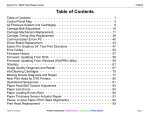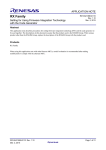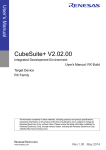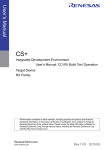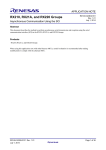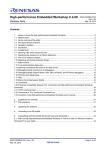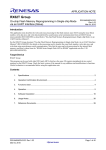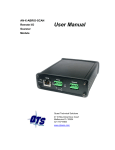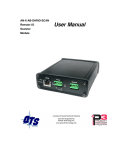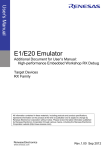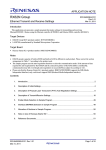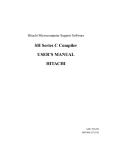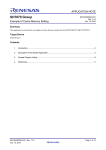Download RX Family Application Note Coding Example of Wait Processing by
Transcript
APPLICATION NOTE
RX Family
Coding Example of Wait Processing by Software
R01AN1852EJ0100
Rev. 1.00
Feb. 3, 2014
Abstract
This document describes a coding example of wait processing by software.
Products
• RX600 Series: RX610 Group, RX62N/621 Group, RX62T Group, RX62G Group, RX630 Group, RX63N/631
Group, RX63T Group
• RX200 Series: RX210 Group, RX220 Group, RX21A Group
• RX100 Series: RX110 Group, RX111 Group
When using this application note with other Renesas MCUs, careful evaluation is recommended after making
modifications to comply with the alternate MCU.
R01AN1852EJ0100 Rev. 1.00
Feb. 3, 2014
Page 1 of 12
RX Family
Coding Example of Wait Processing by Software
Contents
1.
Wait Processing.................................................................................................................................. 3
2.
Operation Confirmation Conditions .................................................................................................... 4
3.
Software ............................................................................................................................................. 6
3.1 Operation Overview ..................................................................................................................... 6
3.2 Coding Examples of Wait Processing .......................................................................................... 6
3.3 Notes on Using Functions ............................................................................................................ 7
3.4 File Composition .......................................................................................................................... 8
3.5 Functions...................................................................................................................................... 8
3.6 Function Specifications ................................................................................................................ 8
3.7 Flowcharts .................................................................................................................................... 9
3.7.1 Function That Specifies the Number of Loops ..................................................................... 9
3.7.2 Function That Specifies Execution Time .............................................................................. 9
4.
Reference ......................................................................................................................................... 10
4.1 Influence of Optimization Options on Instruction Codes ............................................................ 10
4.2 Influence of the Instruction Allocation Address on the Number of Instruction Execution Cycles
11
5.
Sample Code .................................................................................................................................... 12
6.
Reference Documents ...................................................................................................................... 12
R01AN1852EJ0100 Rev. 1.00
Feb. 3, 2014
Page 2 of 12
RX Family
1.
Coding Example of Wait Processing by Software
Wait Processing
When performing wait processing using a loop such as the Do-while statement, the wait time may not match the
intended time for the following reasons.
• In C language, instructions to be output or the number of instructions vary depending on the compiler optimization
options and version, in the result, the number of execution cycles also varies.
• In assembly language, when an instruction straddles the alignment, the number of instruction fetches increases, then
the number of execution cycles will change.
For these reasons, assembly language must be used to have wait processing with a fixed number of execution cycles, so
instructions are not affected by the alignment.
The following pages explain coding examples of wait processing with a fixed number of execution cycles.
R01AN1852EJ0100 Rev. 1.00
Feb. 3, 2014
Page 3 of 12
RX Family
2.
Coding Example of Wait Processing by Software
Operation Confirmation Conditions
The sample code accompanying this application note has been run and confirmed under the conditions below.
Table 2.1 Operation Confirmation Conditions (High-performance Embedded Workshop)
Item
MCU used
Integrated development
environment
C compiler
Contents
R5F563NBDDFC (RX63N Group)
Renesas Electronics
High-performance Embedded Workshop Version 4.09.01
Renesas Electronics
RX Standard Toolchain Version 1.2.1.0
Options
[Compiler]
-cpu=rx600 -output=obj="$(CONFIGDIR)¥$(FILELEAF).obj" -debug
-nologo
[Assembler]
-cpu=rx600 -output="$(CONFIGDIR)¥$(FILELEAF).obj" –debug -nologo
Endian
Sample code version
R01AN1852EJ0100 Rev. 1.00
Feb. 3, 2014
[Linker]
-noprelink -rom=D=R,D_1=R_1,D_2=R_2 –nomessage
-list="$(CONFIGDIR)¥$(PROJECTNAME).map" -nooptimize
-start=B_1,R_1,B_2,R_2,B,R,SU,SI/04,PResetPRG/0FFFF8000,C_1,C_2
,C,C$*,D_1,D_2,D,P,PIntPRG,W*,L/0FFFF8100,FIXEDVECT/0FFFFFFD0
-nologo -output="$(CONFIGDIR)¥$(PROJECTNAME).abs" –end
-input="$(CONFIGDIR)¥$(PROJECTNAME).abs" -form=stype
-output="$(CONFIGDIR)¥$(PROJECTNAME).mot" -exit
Little endian
Version 1.00
Page 4 of 12
RX Family
Coding Example of Wait Processing by Software
Table 2.2 Operation Confirmation Conditions (e2 studio)
Item
MCU used
Integrated development
environment
C compiler
Contents
R5F563NBDDFC (RX63N Group)
Renesas Electronics
e2 studio Version 2.2.0.13
Renesas Electronics
RX Standard Toolchain Version 2.1.0
Options
[Compiler]
-cpu=rx600 -include="${TCINSTALL}¥include" –debug –nologo
-change_message=warning -define=__RX
[Assembler]
-cpu=rx600 -nolistfile
Endian
Sample code version
R01AN1852EJ0100 Rev. 1.00
Feb. 3, 2014
-debug
-nologo
[Linker]
-library="${CONFIGDIR}¥${ProjName}.lib" -noprelink
-list="${ProjName}.map" -show -nooptimize -nomessage -nologo
-output="${CONFIGDIR}¥${ProjName}.abs" -rom=D=R -rom=D_1=R_1
-rom=D_2=R_2
Little endian
Version 1.00
Page 5 of 12
RX Family
3.
Coding Example of Wait Processing by Software
Software
The sample code accompanying this application note has two kinds of wait processing.
• Inline function that specifies the number of loops
• Function that specifies the execution time
3.1
Operation Overview
• Inline function that specifies the number of loops
Loops for the number of loops specified are performed.
This processing is the assembly language inline function, and one loop is executed in five cycles.
The branch instruction placed before entering the loop processing is to clear the CPU instruction queue and used to
match the number of execution cycles between the first loop and the second loop. When the branch instruction is
executed, the instruction queue is cleared, and the CPU starts an instruction fetch from the branch destination.
The NOP instruction is placed in the branch destination to fix the number of cycles regardless of the alignment. The
number of execution cycles for the loop can always be the same by fetching the subsequent instruction while
executing the NOP instruction.
• Function that specifies the execution time
The execution time and the frequency of the system clock (ICLK) are used as arguments, and a waits for the
specified execution time is performed. The number of loops is calculated using the execution time (µs) and the
frequency of the ICLK (kHz) specified in the arguments, and the inline function that specifies the number of loops is
called. As approximately 20 cycles are needed to for a function call and exit, and calculation for the number of loops,
overhead for the cycles is taken into account when calculating the number of loops.
3.2
Coding Examples of Wait Processing
Figure 3.1 shows an example of Coding for the Inline Function That Specifies the Number of Loops.
C source code
void main(void)
{
:
R_DELAY(LOOP_COUNT);
:
}
#pragma inline_asm R_DELAY
static void R_DELAY (unsigned long loop_cnt)
{
BRA ?+
NOP
?:
NOP
SUB #01H,R1
BNE ?}
← Set the number of loops (LOOP_COUNT).
The number of cycles becomes fixed regardless of the alignment.
Figure 3.1 Coding for the Inline Function That Specifies the Number of Loops
In the processing for calling the R_DELAY function, the number of loops (LOOP_COUNT) is specified in the
argument. In the R_DELAY function, one loop is decremented from the number of loop, the loop is repeated until R1
reaches 0. Assuming the number of loops (LOOP_COUNT) is five loops, the execution cycles for the R_DELAY
function is calculated as:
5 loops × 5 cycles = 25 cycles
R01AN1852EJ0100 Rev. 1.00
Feb. 3, 2014
Page 6 of 12
RX Family
Coding Example of Wait Processing by Software
Figure 3.2 shows Coding for the Function That Specifies the Execution Time.
C source code
#include "r_delay.h"
← Include the header file.
void main(void)
{
:
R_DELAY_Us(WAIT_TIME_US, BSP_ICLK_HZ);
:
}
← Set the execution time (WAIT_TIME_US) and ICLK frequency (BSP_ICLK_HZ).
C source code (r_delay.c)
#pragma inline_asm R_DELAY
static void R_DELAY (unsigned long loop_cnt)
{
BRA ?+
NOP
?:
NOP
SUB #01H,R1
BNE ?}
void R_DELAY_Us (unsigned long us, unsigned long khz)
{
signed long loop_cnt;
loop_cnt = us * khz;
loop_cnt = ( loop_cnt / 5000 );
loop_cnt = loop_cnt ? 4;
Calculate the number of loops.
if( loop_cnt > 0 )
{
R_DELAY((unsigned long)loop_cnt);
}
}
Figure 3.2 Coding for the Function That Specifies the Execution Time
In the processing for calling the R_DELAY_Us function, the execution time (WAIT_TIME_US) and ICLK frequency
(BSP_ICLK_HZ) are specified in the argument. In the R_DELAY_Us function, the number of loops is calculated, then
the R_DELAY function is executed using the calculation result as the argument. The number of loops is calculated as
follows:
Number of loops = Execution time (µs) × ICLK (kHz) ÷ 5,000 [execution cycles for 1 loop × 1,000] – 4 loops
[overhead of 20 cycles]
When an execution time of 100 µs and an ICLK frequency of 10,000 kHz (10 MHz)
The number of loops: 100 × 10,000 ÷ 5,000 – 4 = 196 loops
The number of execution cycles: 196 loops × 5 cycles = 980 cycles
Execution time (µs): 10,000 kHz (100 ns) × (980 cycles + 20 cycles [overhead]) = 100 µs
3.3
Notes on Using Functions
This section describes notes on using the functions.
• Inline function that specifies the number of loops
— Do not set the number of loops to 0.
— When executing the function in external memory, the number of cycles for a loop does not become 5 cycles.
• Function that specifies the execution time
— Do not set the execution time and ICLK frequency to 0.
— Set the execution time and ICLK frequency to a whole number.
— The 20-cycle overhead may increase depending on the execution time (µs) and ICLK frequency (kHz) values.
— The calculated result for the number of loops is rounded off to the nearest whole number. Specify the execution
time taking the rounding off into consideration.
R01AN1852EJ0100 Rev. 1.00
Feb. 3, 2014
Page 7 of 12
RX Family
3.4
Coding Example of Wait Processing by Software
File Composition
Table 3.1 lists the Files Used in the Sample Code.
Table 3.1 Files Used in the Sample Code
File Name
r_delay.c
r_delay.h
3.5
Outline
Wait processing by software
Remarks
Header file for r_delay.c
Functions
Table 3.2 lists the Functions.
Table 3.2 Functions
Function Name
Outline
R_DELAY
Inline function that specifies the number of loops
R_DELAY_Us
Function that specifies the execution time
3.6
Function Specifications
The following tables list the sample code function specifications.
R_DELAY
Outline
Header
Declaration
Description
Arguments
Return Value
Remarks
R_DELAY_Us
Outline
Header
Declaration
Description
Arguments
Return Value
Inline function that specifies the number of loops
None
static void R_DELAY (unsigned long loop_cnt)
Wait processing that loops at a fixed five cycles.
loop_cnt : Number of loops
None
This function is the assembly language inline function. When using this function, write the
function codes in the appropriate source file. By adding a NOP instruction in the start of
the loop processing, the number of cycles for a loop can be adjusted.
Function that specifies the execution time
r_delay.h
void R_DELAY_Us (unsigned long us, unsigned long khz)
The number of loops are calculated based on the execution time (µs) and ICLK
frequency, and the inline function that specifies the number of loops is called.
us
: Execution time
khz : ICLK frequency when calling the function
None
R01AN1852EJ0100 Rev. 1.00
Feb. 3, 2014
Page 8 of 12
RX Family
3.7
3.7.1
Coding Example of Wait Processing by Software
Flowcharts
Function That Specifies the Number of Loops
Figure 3.3 shows the Function That Specifies the Number of Loops.
R_DELAY
Argument
R1: Number of loops
NOP
Decrement the number of loops R1 ← R1 - 1
No
Is the number
of loops 0 ?
Yes
return
Figure 3.3 Function That Specifies the Number of Loops
3.7.2
Function That Specifies Execution Time
Figure 3.4 shows the Function That Specifies Execution Time.
R_DELAY_Us
Arguments
unsigned long us: Execution time
unsigned long khz: ICLK frequency when calling the function
Calculate the number of loops loop_cnt ← us * khz
loop_cnt ← loop_cnt / 5000
loop_cnt ← loop_cnt - 4
Is the number of
loops 1 or more?
No
Yes
Inline function that
specifies the number of
loops
R_DELAY()
return
Figure 3.4 Function That Specifies Execution Time
R01AN1852EJ0100 Rev. 1.00
Feb. 3, 2014
Page 9 of 12
RX Family
4.
Coding Example of Wait Processing by Software
Reference
The following explains how the number of execution cycles varies.
4.1
Influence of Optimization Options on Instruction Codes
When using C language to write wait processing, if the optimization options or compiler version on the compile process
differ, the type and number of instructions to be output differ, and then the number of execution cycles in the wait
processing changes.
Table 3.1 lists examples of optimization options and instructions that are output.
Table 4.1 Optimization Options and Instructions That are Output
C Language Source
Wait processing using a Do-while
statement
void Software_delay (unsigned long count)
{
do
{
count--;
} while (count);
}
Example of Compile Results
Optimization level: 0
1 loop: 6 instructions
_Software_delay:
.STACK
_Software_delay=8
SUB #04H, R0
MOV.L R1, [R0]
L1:
MOV.L [R0], R1
SUB #01H, R1
MOV.L R1, [R0]
L2:
MOV.L [R0], R1
CMP #00H, R1
BNE L1
L3:
RTSD #04H
R01AN1852EJ0100 Rev. 1.00
Feb. 3, 2014
Optimization level: 1
Optimization type: Size prioritized
1 loop: 4 instructions
_Software_delay:
.STACK
_Software_delay=4
L1:
ADD 0FFFFFFFFH, R1, R14
CMP #01H, R1
MOV.L R14, R1
BNE L1
L2:
RTS
Optimization level: 2
Optimization type: Size prioritized
1 loop: 2 instructions
_Software_delay:
.STACK
_Software_delay=4
L1:
SUB #01H, R1
BNE L1
L2:
RTS
Page 10 of 12
RX Family
4.2
Coding Example of Wait Processing by Software
Influence of the Instruction Allocation Address on the Number of Instruction
Execution Cycles
When the code size of the instruction code is 2 bytes or more, and the allocation address of the instruction code
straddles the alignment, the fetch for the instruction is performed twice, then the number of execution cycles may
increase by one cycle.
The sample code below is an example to show how the number of execution cycles increases in wait processing.
In Figure 4.1, when the sample shown on the left is compiled, instruction codes are output as shown on the right.
When the SUB instruction address is allocated to an address that does not straddle the alignment as shown in “Pattern
A” of Figure 4.2, the instruction fetch is only performed once, then the number of execution cycles for the SUB
instruction is one cycle.
When the SUB instruction address is allocated to an address that straddles the alignment as shown in “Pattern B” of
Figure 4.2, the instruction fetch is performed twice, then the number of execution cycles for the SUB instruction
becomes two cycles.
Sample code
Compile result (assembler)
count = XX;
do
{
count--;
} while (count);
Address
FFFFXXXX
FFFFXXXX
FFFFXXXX+2
Instruction code
Label:
6011
21rr
SUB #01H, R1
BNE Label
(XX: Number of loops)
Figure 4.1 Compile Result of the Sample Code
This diagram assumes 4-byte alignment CPU
Pattern A: When the number of execution cycles does not increase
3
2
1
4n
SUB instruction
0
SUB instruction
Instruction fetch 1
BNE instruction
4(n+1)
Instruction fetch 2
The SUB instruction code falls within the 4-byte alignment, thus the instruction fetch is performed once.
Pattern B: When the number of execution cycles increases
3
2
1
4n
0
SUB instruction
4(n+1)
Instruction fetch 1
BNE instruction
SUB instruction
Instruction fetch 2
The SUB instruction code does not fall within the 4-byte alignment, then the instruction fetch is performed
twice for this instruction, in the result, the number of execution cycles becomes two.
Figure 4.2 Allocation Address of the Instruction and the Number of Instruction Execution Cycles
R01AN1852EJ0100 Rev. 1.00
Feb. 3, 2014
Page 11 of 12
RX Family
5.
Coding Example of Wait Processing by Software
Sample Code
Sample code can be downloaded from the Renesas Electronics website.
6.
Reference Documents
User’s Manual: Software
RX Family User’s Manual: Software Rev.1.20 (R01US0032EJ)
The latest version can be downloaded from the Renesas Electronics website.
Technical Update/Technical News
The latest information can be downloaded from the Renesas Electronics website.
User’s Manual: Development Tools
RX Family C/C++ Compiler Package V.1.01 User’s Manual Rev.1.00 (R20UT0570EJ)
The latest version can be downloaded from the Renesas Electronics website.
RX Family CC-RX V2.01.00 User’s Manual: RX Coding (R20UT2748EJ)
The latest version can be downloaded from the Renesas Electronics website.
Website and Support
Renesas Electronics website
http://www.renesas.com
Inquiries
http://www.renesas.com/contact/
R01AN1852EJ0100 Rev. 1.00
Feb. 3, 2014
Page 12 of 12
RX Family Application Note
Coding Example of Wait Processing by Software
REVISION HISTORY
Rev.
Date
1.00
Feb. 3, 2014
Page
—
Description
Summary
First edition issued
All trademarks and registered trademarks are the property of their respective owners.
A-1
General Precautions in the Handling of MPU/MCU Products
The following usage notes are applicable to all MPU/MCU products from Renesas. For detailed usage notes on the
products covered by this document, refer to the relevant sections of the document as well as any technical updates that
have been issued for the products.
1. Handling of Unused Pins
Handle unused pins in accordance with the directions given under Handling of Unused Pins in the
manual.
⎯ The input pins of CMOS products are generally in the high-impedance state. In operation with an
unused pin in the open-circuit state, extra electromagnetic noise is induced in the vicinity of LSI, an
associated shoot-through current flows internally, and malfunctions occur due to the false
recognition of the pin state as an input signal become possible. Unused pins should be handled as
described under Handling of Unused Pins in the manual.
2. Processing at Power-on
The state of the product is undefined at the moment when power is supplied.
⎯ The states of internal circuits in the LSI are indeterminate and the states of register settings and
pins are undefined at the moment when power is supplied.
In a finished product where the reset signal is applied to the external reset pin, the states of pins
are not guaranteed from the moment when power is supplied until the reset process is completed.
In a similar way, the states of pins in a product that is reset by an on-chip power-on reset function
are not guaranteed from the moment when power is supplied until the power reaches the level at
which resetting has been specified.
3. Prohibition of Access to Reserved Addresses
Access to reserved addresses is prohibited.
⎯ The reserved addresses are provided for the possible future expansion of functions. Do not access
these addresses; the correct operation of LSI is not guaranteed if they are accessed.
4. Clock Signals
After applying a reset, only release the reset line after the operating clock signal has become stable.
When switching the clock signal during program execution, wait until the target clock signal has
stabilized.
⎯ When the clock signal is generated with an external resonator (or from an external oscillator)
during a reset, ensure that the reset line is only released after full stabilization of the clock signal.
Moreover, when switching to a clock signal produced with an external resonator (or by an external
oscillator) while program execution is in progress, wait until the target clock signal is stable.
5. Differences between Products
Before changing from one product to another, i.e. to a product with a different part number, confirm
that the change will not lead to problems.
⎯ The characteristics of an MPU or MCU in the same group but having a different part number may
differ in terms of the internal memory capacity, layout pattern, and other factors, which can affect
the ranges of electrical characteristics, such as characteristic values, operating margins, immunity
to noise, and amount of radiated noise. When changing to a product with a different part number,
implement a system-evaluation test for the given product.
Notice
1.
Descriptions of circuits, software and other related information in this document are provided only to illustrate the operation of semiconductor products and application examples. You are fully responsible for
the incorporation of these circuits, software, and information in the design of your equipment. Renesas Electronics assumes no responsibility for any losses incurred by you or third parties arising from the
use of these circuits, software, or information.
2.
Renesas Electronics has used reasonable care in preparing the information included in this document, but Renesas Electronics does not warrant that such information is error free. Renesas Electronics
3.
Renesas Electronics does not assume any liability for infringement of patents, copyrights, or other intellectual property rights of third parties by or arising from the use of Renesas Electronics products or
assumes no liability whatsoever for any damages incurred by you resulting from errors in or omissions from the information included herein.
technical information described in this document. No license, express, implied or otherwise, is granted hereby under any patents, copyrights or other intellectual property rights of Renesas Electronics or
others.
4.
You should not alter, modify, copy, or otherwise misappropriate any Renesas Electronics product, whether in whole or in part. Renesas Electronics assumes no responsibility for any losses incurred by you or
5.
Renesas Electronics products are classified according to the following two quality grades: "Standard" and "High Quality". The recommended applications for each Renesas Electronics product depends on
third parties arising from such alteration, modification, copy or otherwise misappropriation of Renesas Electronics product.
the product's quality grade, as indicated below.
"Standard": Computers; office equipment; communications equipment; test and measurement equipment; audio and visual equipment; home electronic appliances; machine tools; personal electronic
equipment; and industrial robots etc.
"High Quality": Transportation equipment (automobiles, trains, ships, etc.); traffic control systems; anti-disaster systems; anti-crime systems; and safety equipment etc.
Renesas Electronics products are neither intended nor authorized for use in products or systems that may pose a direct threat to human life or bodily injury (artificial life support devices or systems, surgical
implantations etc.), or may cause serious property damages (nuclear reactor control systems, military equipment etc.). You must check the quality grade of each Renesas Electronics product before using it
in a particular application. You may not use any Renesas Electronics product for any application for which it is not intended. Renesas Electronics shall not be in any way liable for any damages or losses
incurred by you or third parties arising from the use of any Renesas Electronics product for which the product is not intended by Renesas Electronics.
6.
You should use the Renesas Electronics products described in this document within the range specified by Renesas Electronics, especially with respect to the maximum rating, operating supply voltage
range, movement power voltage range, heat radiation characteristics, installation and other product characteristics. Renesas Electronics shall have no liability for malfunctions or damages arising out of the
use of Renesas Electronics products beyond such specified ranges.
7.
Although Renesas Electronics endeavors to improve the quality and reliability of its products, semiconductor products have specific characteristics such as the occurrence of failure at a certain rate and
malfunctions under certain use conditions. Further, Renesas Electronics products are not subject to radiation resistance design. Please be sure to implement safety measures to guard them against the
possibility of physical injury, and injury or damage caused by fire in the event of the failure of a Renesas Electronics product, such as safety design for hardware and software including but not limited to
redundancy, fire control and malfunction prevention, appropriate treatment for aging degradation or any other appropriate measures. Because the evaluation of microcomputer software alone is very difficult,
please evaluate the safety of the final products or systems manufactured by you.
8.
Please contact a Renesas Electronics sales office for details as to environmental matters such as the environmental compatibility of each Renesas Electronics product. Please use Renesas Electronics
products in compliance with all applicable laws and regulations that regulate the inclusion or use of controlled substances, including without limitation, the EU RoHS Directive. Renesas Electronics assumes
no liability for damages or losses occurring as a result of your noncompliance with applicable laws and regulations.
9.
Renesas Electronics products and technology may not be used for or incorporated into any products or systems whose manufacture, use, or sale is prohibited under any applicable domestic or foreign laws or
regulations. You should not use Renesas Electronics products or technology described in this document for any purpose relating to military applications or use by the military, including but not limited to the
development of weapons of mass destruction. When exporting the Renesas Electronics products or technology described in this document, you should comply with the applicable export control laws and
regulations and follow the procedures required by such laws and regulations.
10. It is the responsibility of the buyer or distributor of Renesas Electronics products, who distributes, disposes of, or otherwise places the product with a third party, to notify such third party in advance of the
contents and conditions set forth in this document, Renesas Electronics assumes no responsibility for any losses incurred by you or third parties as a result of unauthorized use of Renesas Electronics
products.
11. This document may not be reproduced or duplicated in any form, in whole or in part, without prior written consent of Renesas Electronics.
12. Please contact a Renesas Electronics sales office if you have any questions regarding the information contained in this document or Renesas Electronics products, or if you have any other inquiries.
(Note 1)
"Renesas Electronics" as used in this document means Renesas Electronics Corporation and also includes its majority-owned subsidiaries.
(Note 2)
"Renesas Electronics product(s)" means any product developed or manufactured by or for Renesas Electronics.
http://www.renesas.com
SALES OFFICES
Refer to "http://www.renesas.com/" for the latest and detailed information.
Renesas Electronics America Inc.
2801 Scott Boulevard Santa Clara, CA 95050-2549, U.S.A.
Tel: +1-408-588-6000, Fax: +1-408-588-6130
Renesas Electronics Canada Limited
1101 Nicholson Road, Newmarket, Ontario L3Y 9C3, Canada
Tel: +1-905-898-5441, Fax: +1-905-898-3220
Renesas Electronics Europe Limited
Dukes Meadow, Millboard Road, Bourne End, Buckinghamshire, SL8 5FH, U.K
Tel: +44-1628-585-100, Fax: +44-1628-585-900
Renesas Electronics Europe GmbH
Arcadiastrasse 10, 40472 Düsseldorf, Germany
Tel: +49-211-6503-0, Fax: +49-211-6503-1327
Renesas Electronics (China) Co., Ltd.
Room 1709, Quantum Plaza, No.27 ZhiChunLu Haidian District, Beijing 100191, P.R.China
Tel: +86-10-8235-1155, Fax: +86-10-8235-7679
Renesas Electronics (Shanghai) Co., Ltd.
Unit 301, Tower A, Central Towers, 555 Langao Road, Putuo District, Shanghai, P. R. China 200333
Tel: +86-21-2226-0888, Fax: +86-21-2226-0999
Renesas Electronics Hong Kong Limited
Unit 1601-1613, 16/F., Tower 2, Grand Century Place, 193 Prince Edward Road West, Mongkok, Kowloon, Hong Kong
Tel: +852-2265-6688, Fax: +852 2886-9022/9044
Renesas Electronics Taiwan Co., Ltd.
13F, No. 363, Fu Shing North Road, Taipei 10543, Taiwan
Tel: +886-2-8175-9600, Fax: +886 2-8175-9670
Renesas Electronics Singapore Pte. Ltd.
80 Bendemeer Road, Unit #06-02 Hyflux Innovation Centre, Singapore 339949
Tel: +65-6213-0200, Fax: +65-6213-0300
Renesas Electronics Malaysia Sdn.Bhd.
Unit 906, Block B, Menara Amcorp, Amcorp Trade Centre, No. 18, Jln Persiaran Barat, 46050 Petaling Jaya, Selangor Darul Ehsan, Malaysia
Tel: +60-3-7955-9390, Fax: +60-3-7955-9510
Renesas Electronics Korea Co., Ltd.
12F., 234 Teheran-ro, Gangnam-Ku, Seoul, 135-920, Korea
Tel: +82-2-558-3737, Fax: +82-2-558-5141
© 2014 Renesas Electronics Corporation. All rights reserved.
Colophon 4.0















